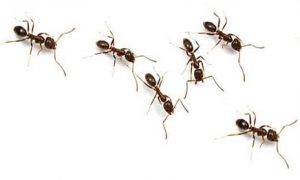How Did I Get Ants?
Poor sanitation is the primary cause of ant infestations. Leaving dirty dishes in the sink, food residue on countertops, crumbs on the floor and trash not frequently emptied provide food sources for meal-seeking ants. What starts with a few foragers entering a home can become a major problem if ants establish colonies in walls, lawns, or under home foundations.
How Serious Are Ants?
One of the biggest problems related to ants in the home is food contamination. Ants carry bacteria on their bodies, which spreads when they crawl in pantries and across countertops. Only a few species are known to transmit diseases, but finding any type of ant in pantry goods or inside the home is an unpleasant experience that creates nuisances.
Some species, like carpenter and fire ants, cause additional problems. A carpenter ant infestation can do costly damage by chewing tunnels through wood beams. Fire ant stings that involve envenomation can cause pain and more serious symptoms that often result in allergic reactions to some people who are hyper-sensitive to ant stings.
How Serious Are Ants?
One of the biggest problems related to ants in the home is food contamination. Ants carry bacteria on their bodies, which spreads when they crawl in pantries and across countertops. Only a few species are known to transmit diseases, but finding any type of ant in pantry goods or inside the home is an unpleasant experience that creates nuisances.
Some species, like carpenter and fire ants, cause additional problems. A carpenter ant infestation can do costly damage by chewing tunnels through wood beams. Fire ant stings that involve envenomation can cause pain and more serious symptoms that often result in allergic reactions to some people who are hyper-sensitive to ant stings.
Ant control can be difficult, but there are some things you should know about how ants’ behavior can lead to big headaches for you and your home:
- Entry: Ants can enter through even the tiniest cracks, seeking water and sweet or greasy food substances in the kitchen pantry or storeroom areas.
- Scent trails: Ants leave an invisible chemical trail which contains pheromones for others to follow once they locate the food source.
- Nest locations: They can nest about anywhere in and around your house; in lawns, walls, stumps, even under foundations.
- Colony size: Colonies can number up to 300,000 to 500,000, and whole colonies can uproot and relocate quickly when threatened.
- Colony Lifetime: A colony can live a relatively long lifetime. Worker ants may live seven years, and the queen may live as long as 15 years.
- Do it yourself effectiveness: Most do-it-yourself ant control approaches kill only the ants you see. Some truly effective treatments can penetrate and destroy nests to help prevent these pests from returning. Also, home remedies don’t account for the fact that different kinds of ant infestations require different treatments.
Ant Life Cycle
The ant life cycle has four distinct and very different life stages: egg, larvae, pupae and adult. This is known as complete metamorphosis. It generally takes from several weeks to several months to complete the life cycle, depending upon the ant species and environmental factors.
Eggs
A female ant that successfully mates with a male ant will become a queen ant that lays eggs. Fertile queens select a sheltered place to begin a nest (colony) and begin laying eggs. Ant eggs are very small – only about a half of a millimeter in diameter. The eggs are also oval, white and transparent.
Larvae
After about 1-2 weeks in the egg stage, a grub-like, legless ant larvae hatches. This stage has a voracious appetite, and the adult ants spend much of their time feeding the larvae with food and liquids they digest and regurgitate.
Pupae
After the larvae molts and shed their skin, they change into the pupal stage. Pupae appear somewhat like adults except their legs and antennae are folded and pressed against the pupal body. Initially, ant pupae are usually white, but slowly become darker in color as they age. Depending upon the ant species, pupae may be housed in a protective cocoon.
Adult
Once the pupal stage is complete, the adult ant comes on the scene. At the time of emergence, the adult ant is fully grown, but darkens in color as it ages. Adult ants are one of three different colony castes; queens, workers or males. Queens are fertile females that lay all the eggs in a colony. Workers are females that do not reproduce, but do gather food; feed the larvae; and maintain and clean the nest. Workers are wingless, and it is the worker stage that is seen foraging around for food or defending the colony from intruders. The male ants are winged, but their only job is to mate with the queens during the swarming process.


